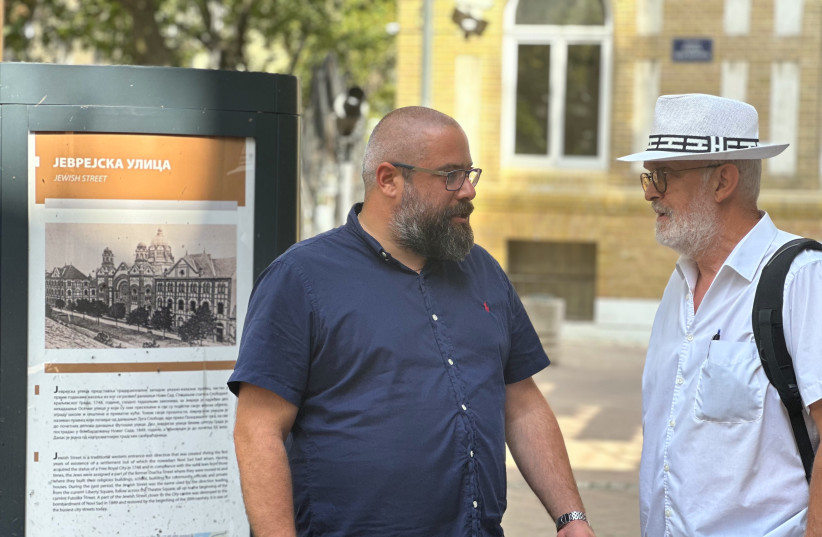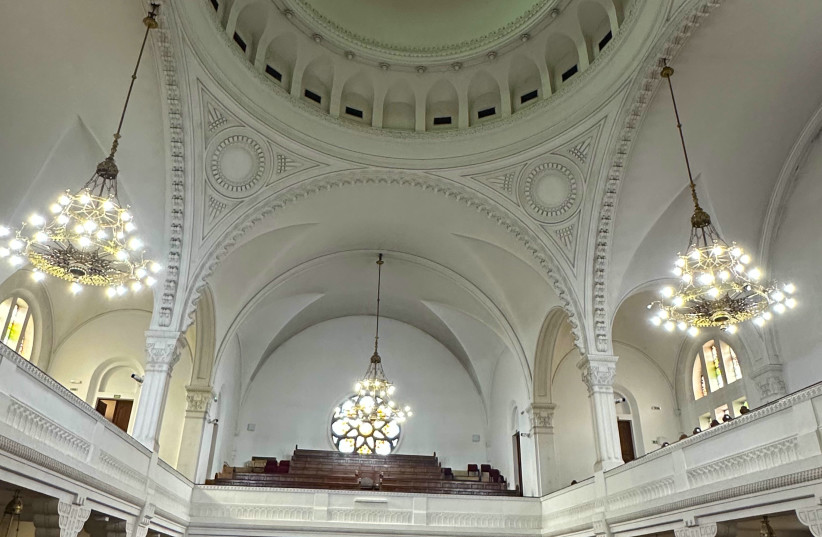In the heart of downtown in Serbia’s second-largest city, nestled between brick buildings on a leafy street, sits a large synagogue.
With its 130-foot-high central dome and faded yellow brick facade, along with its Jewish school and offices on either side, the synagogue’s three-building complex has become a must-see tourist attraction, with multilingual panels in its courtyard explaining the area’s Jewish history.
The synagogue was built to accommodate up to 950 worshippers in the first decade of the 20th century. But like the city and Serbia more broadly, the building has clearly seen better days. On two recent days, a family was camped outside the entrance, begging passersby for money.
Before World War II, Novi Sad had roughly 60,000 inhabitants, 4,300 of whom were Jews — about 7% of the total population. Most were affluent merchants, lawyers, doctors, and professors. Their wealth was reflected in the city’s opulent synagogue, constructed between 1906 and 1909 by Hungarian Jewish architect Lipot Baumhorn, whose work incorporated elements of the Art Nouveau movement.

Today, however, the prominent building serves a dwindling community that, like others decimated by the Holocaust and further eroded by the Balkan wars of the 1990s, fears for its future as residents disperse abroad. Only about 640 Jews remain in Novi Sad; others have sought a future in Israel or countries that offer more economic opportunity.
“We use our own shul only for Yom Kippur,” said Novi Sad native Ladislav Trajer, the deputy president of the Federation of Jewish Communities of Serbia.
“We get six to 10 people for Shabbat — maybe 15 — but fewer than half are male so we can’t make a minyan,” said Trajer, referencing a Jewish prayer quorum of 10 men. He spent eight years in Israel and also served in the Israel Defense Forces. “Even in Belgrade, which is much larger, the rabbi doesn’t always get a minyan. And nobody here keeps kosher. You can’t get kosher meat.”
A Jewish hub in Serbia's demise
Novi Sad was a thriving center of Jewish life in prewar Yugoslavia and the city — now a metropolis of 370,000 sometimes called the “Serbian Athens” — was named a European Culture Capital of 2022 for its arts, food, architecture, and other cultural scenes.
But most local Jews see few prospects for themselves in a country beset by economic turmoil. Between 1990 and 2000 — following Yugoslavia’s collapse; the ethnic wars in Croatia, Bosnia, and later Kosovo; and the imposition of crippling sanctions by the United States, the European Union and the United Nations — Serbia’s GDP tumbled from $24 billion to $8.7 billion. By 1993, nearly 40% of Serbia’s people were living on less than $2 a day, and at present, the average Serb earns approximately $430 to $540 a month.
Despite those difficulties, Serbia agreed in 2017 to pay just over $1 million annually over the ensuing 25 years to its remaining Jews as compensation for property nationalized by the postwar communist regime. Half of that money goes directly to Jewish community organizations, 20% to Holocaust survivors, and the remaining 30% to projects that aim to preserve Jewish traditions.
Since 2012, the Novi Sad community has also earned income by renting out its huge synagogue to the municipality for classical music concerts. In return, the city maintains the complex as a historic monument, and it is now repairing the synagogue’s roof and fixing leaky water pipes.
“These buildings were close to collapse,” said Trajer. He added that the city’s neglected Jewish cemetery can look like a forest. “So we are cutting the trees and struggling to put up fences.”
Although antisemitic incidents are not too common, Serbia, like most other countries in Eastern Europe, also contends with a strong nationalist streak. Trajer, who monitors antisemitism closely, said around 1,500 Serbs belong to extremist groups, of which perhaps 120 are active. Serbian Action, a small group of neo-Nazis, occasionally holds rallies and spray-paints antisemitic, anti-immigrant and anti-gay graffiti on public buildings.
“In high school, my history professor joked that Hitler couldn’t get into an art academy, and that’s why he decided to kill the Jews,” said Teodora Paljic, a 20-year-old Jewish university student. “I don’t talk about these things with people I don’t feel safe around.”
She said that “Life in Serbia is very difficult” because “all the prices have gone up, but salaries haven’t increased since 2019.”
Novi Sad is the capital of Vojvodina, an autonomous province that covers much of northern Serbia, and at the local Jewish community’s zenith, 86 synagogues flourished in the province. Today, only 11 remain standing, and most have fallen into disuse.
Mirko Štark, president of the Jewish Community of Novi Sad, said Jews first settled in the city in the 17th century, shortly after its founding in 1694 under the Hapsburg monarchy.
“When the Austro-Hungarian Empire, where most Ashkenazim lived, introduced new laws that restricted Jews from living in cities, many people ran to the border area, where these laws were not so strictly enforced,” Štark said. Later, when the Serbs captured Vojvodina, those restrictions were rescinded, and the Jewish community blossomed.
Following World War I and the establishment of the Kingdom of Serbs, Croats, and Slovenes — later Yugoslavia — Novi Sad’s Jews enjoyed a cultural and economic renaissance that saw the formation of a Jewish community center, athletic clubs, choirs, and several Jewish newspapers.
That renaissance ended abruptly in 1941, when the Hungarian army, in collaboration with Nazi Germany, occupied Novi Sad, making life for Jews intolerable. Over a three-day period in January 1942 now known as the Novi Sad Massacre, the Hungarians rounded up more than 1,400 Jews, seized their property, shot them in their backs, and threw them into the freezing Danube River.
After Hungary’s capitulation to Germany, armed guards herded the city’s remaining 1,800 Jews into the synagogue and kept them there for two days in deplorable conditions without food or water. On April 27, 1944, the Nazis marched their weakened Jewish captives to the train station, then forced them on a train to Auschwitz that took two months to arrive due to Allied bombing.
Only 300 of Novi Sad’s Jews survived the Holocaust and rebuilt the community virtually from scratch in the ensuing postwar chaos.
“There were no religious people anymore, and no rabbi,” said Štark. “Many went to Israel in the first aliyah. The small number of Jews remaining tried to keep the community alive, opening a kitchen to provide food for people who couldn’t buy for themselves. My grandmother survived Auschwitz. She worked in that kitchen.”
According to Trajer, from 1948 to 2022, no Shabbat services were held. These days, Trajer conducts all religious services because he’s the only one who knows the Hebrew prayers fluently.
Novi Sad's Jewish community today

With 640 members, Novi Sad has the nation’s second-largest Jewish population after Belgrade. The capital is home to more than half of the country’s 3,000 Jews, out of a total population of 7.1 million. Smaller Jewish communities can also be found in Subotica, Niš and other cities. Only the synagogues in Belgrade and Subotica — the latter located a few miles from the Hungarian border — still function.
Most members of the Novi Sad community, including Štark, have married non-Jews.
“My wife is not Jewish. Neither was my mother. Only my father was Jewish,” he said. “After World War II, choices for finding husbands and wives within the community were limited. For this reason, we accept non-Jewish spouses as members. This is the only way to survive.”
Štark, 70, is a retired professor of media production who worked for years at Novi Sad’s main TV station. He’s also the longtime president of the synagogue’s choir, HaShira, which sings in Hebrew, Ladino, and Yiddish and recently won an award for its performances in neighboring Montenegro. Only three of the choir’s 35 members are Jews.
“When I began my mandate as president a year and a half ago, we woke up many activities in the Jewish community that had existed only on a small scale before,” he said.
Besides the choir, these include the Zmaya dance troupe as well as a Jewish culture club that meets every Tuesday at 6 p.m. to discuss books and Israeli movies. There’s also a “baby club” for small children and another club for teens, whose activities are led by two adults. Hanukkah and Passover are celebrated by families together and on Tu B’Shvat, the community plants trees.
The community is also investing in its members, and Paljic is emblematic of that hope.
Paljic, interviewed at the trendy Café Petrus, a 15-minute walk from Novi Sad’s Jewish cemetery, is the daughter of Jewish parents who met at a Purim party in Belgrade.
“My grandparents were killed in Jasenovac [a notoriously brutal concentration camp], but my best friend’s grandmother survived Auschwitz,” she said. “The problem is, people don’t talk about Judaism because they’re scared. There is still antisemitism. Last year, somebody drew a swastika at the entrance to the Jewish cemetery in Belgrade. We were all shocked.”
This summer, Paljic worked as a counselor at Hungary’s Camp Szarvas, which brings together young Jews from throughout Central and Eastern Europe. The camp welcomed 20 children from Novi Sad this year; the American Jewish Joint Distribution Committee paid their tuition.
While she would like to be close to her family, Paljic said she must be practical.
“I want to go somewhere outside Serbia when I finish college,” she said. “I don’t see my career here. I love art history and photography, but there’s no money in that in Serbia.”
Despite the challenges, Štark isn’t ready to say kaddish for Novi Sad’s Jews just yet.
“We will keep the Jewish spirit alive here. We are working hard, starting with the children,” he said. “If we don’t, everything will die in five or 10 years. So it depends on us.”
